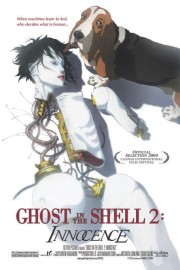Ghost in the Shell 2: Innocence
Mamoru Oshii’s “Ghost in the Shell” is the greatest work of Japanese animation not made by Hayao Miyazaki. What Americans typically think of when they think of anime, “Ghost in the Shell” does better than any other film. That it is great science fiction on top of that, exploring the question of reality and humanity in a largely artificial work, makes it doubly wonderful for a genre fan like me. Compared to Oshii’s film, “The Matrix” is a pretender to the throne of action-packed, speculative sci-fi. While the 2004 sequel, “Ghost in the Shell 2: Innocence,” found its way into American theatres, projection issues the day friends and I went to go see it meant having to wait for DVD. It did not disappoint, although watching it again, I forgot just how good the film is.
Before I dive into the story, the animation in “Ghost in the Shell: Innocence” must be addressed. Almost 10 years had passed between the first and second film, and while the original remains a riveting visual film to watch, “Innocence” takes it up several notches with CG-enhanced animation (by this point, the TV series, “Stand Alone Complex,” had started) that deepens and enriches the film’s world. This is really noticeable in the second half of the film, when Batou and his partner locate a hacker they believe is causing robots to revolt against their programming. From the moment they come up to the mansion they are supposedly housed in, and walk in, the images are stunning to behold. The depth and potency of the colors we see are nothing short of amazing, and the way the lighting works in the hallways, giving it a sheen we didn’t get in the original film. There’s much to be said, and loved, about Oshii’s hand-drawn work in the original film, but with the work in “Innocence,” the visuals open up the story 10-fold, even though that story, adapted from the Manga by Masamune Shirow, drags along a little too long compared to the brisk storytelling of the 1995 film.
It’s a fair point that, when it comes to sci-fi anime films, the stories tend to get ridiculously convoluted, and can be difficult to follow for American audiences, in general. Both of these “Ghost in the Shell” films keep that tradition alive and well, although the concepts within the films itself, about virtual reality, the nature of humanity, and the fact that both heroes and villains feel more like consciousness in a machine rather than material entities, certainly aid in the convolution. Batou is now a lead detective at Public Security Section 9 with a new partner, Togusa, after his previous partner, Motoko, disappeared into the internet somewhere after their dealings with the Puppet Master in the first film. He and Togusa are now investigating murders by robots, which right now, includes a couple of cops and a politician. Is it the programming of the machines that is causing these violent crimes, or the work of a hacker not unlike the Puppet Master? The answer becomes clear when Batou is in a shootout, and he is almost made to kill the shopkeeper. The question then becomes, is this a single hacker working alone, or maybe a larger conspiracy involving a company known for a particular type of “doll?” Either way, it’s going to be a difficult case for Batou to close.
Especially coming off of the muddled narratives of the “Matrix” sequels,” “Innocence” was a blast of fresh air at the time when it came to smart, exciting sci-fi sequels, and it remains that 13 years later. I’ve always wanted to dig further into the “Ghost in the Shell” universe that has cropped up since the original film 22 years ago, but I’ve always had so much more to catch up with I’ve never been able to. For now, the first two films from Mamoru Oshii will have to be enough, and from a visual and intellectual level, they are certainly that, delving deep into the notion of reality, and challenging us with what that concept means. In the perilous times we currently live in, I can’t think of a more appropriate story to dive into that this.










